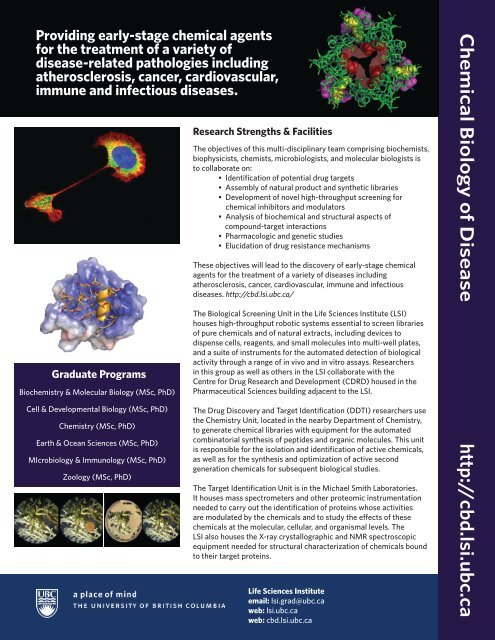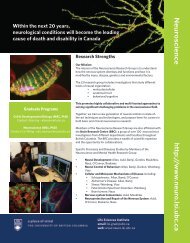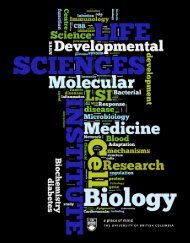Chemical Biology of Disease - University of British Columbia
Chemical Biology of Disease - University of British Columbia
Chemical Biology of Disease - University of British Columbia
You also want an ePaper? Increase the reach of your titles
YUMPU automatically turns print PDFs into web optimized ePapers that Google loves.
Providing early-stage chemical agents<br />
for the treatment <strong>of</strong> a variety <strong>of</strong><br />
disease-related pathologies including<br />
atherosclerosis, cancer, cardiovascular,<br />
immune and infectious diseases.<br />
Graduate Programs<br />
Biochemistry & Molecular <strong>Biology</strong> (MSc, PhD)<br />
Cell & Developmental <strong>Biology</strong> (MSc, PhD)<br />
Chemistry (MSc, PhD)<br />
Earth & Ocean Sciences (MSc, PhD)<br />
MIcrobiology & Immunology (MSc, PhD)<br />
Zoology (MSc, PhD)<br />
Research Strengths & Facilities<br />
The objectives <strong>of</strong> this multi-disciplinary team comprising biochemists,<br />
biophysicists, chemists, microbiologists, and molecular biologists is<br />
to collaborate on:<br />
• Identification <strong>of</strong> potential drug targets<br />
• Assembly <strong>of</strong> natural product and synthetic libraries<br />
• Development <strong>of</strong> novel high-throughput screening for<br />
chemical inhibitors and modulators<br />
• Analysis <strong>of</strong> biochemical and structural aspects <strong>of</strong><br />
compound-target interactions<br />
• Pharmacologic and genetic studies<br />
• Elucidation <strong>of</strong> drug resistance mechanisms<br />
These objectives will lead to the discovery <strong>of</strong> early-stage chemical<br />
agents for the treatment <strong>of</strong> a variety <strong>of</strong> diseases including<br />
atherosclerosis, cancer, cardiovascular, immune and infectious<br />
diseases. http://cbd.lsi.ubc.ca/<br />
The Biological Screening Unit in the Life Sciences Institute (LSI)<br />
houses high-throughput robotic systems essential to screen libraries<br />
<strong>of</strong> pure chemicals and <strong>of</strong> natural extracts, including devices to<br />
dispense cells, reagents, and small molecules into multi-well plates,<br />
and a suite <strong>of</strong> instruments for the automated detection <strong>of</strong> biological<br />
activity through a range <strong>of</strong> in vivo and in vitro assays. Researchers<br />
in this group as well as others in the LSI collaborate with the<br />
Centre for Drug Research and Development (CDRD) housed in the<br />
Pharmaceutical Sciences building adjacent to the LSI.<br />
The Drug Discovery and Target Identification (DDTI) researchers use<br />
the Chemistry Unit, located in the nearby Department <strong>of</strong> Chemistry,<br />
to generate chemical libraries with equipment for the automated<br />
combinatorial synthesis <strong>of</strong> peptides and organic molecules. This unit<br />
is responsible for the isolation and identification <strong>of</strong> active chemicals,<br />
as well as for the synthesis and optimization <strong>of</strong> active second<br />
generation chemicals for subsequent biological studies.<br />
The Target Identification Unit is in the Michael Smith Laboratories.<br />
It houses mass spectrometers and other proteomic instrumentation<br />
needed to carry out the identification <strong>of</strong> proteins whose activities<br />
are modulated by the chemicals and to study the effects <strong>of</strong> these<br />
chemicals at the molecular, cellular, and organismal levels. The<br />
LSI also houses the X-ray crystallographic and NMR spectroscopic<br />
equipment needed for structural characterization <strong>of</strong> chemicals bound<br />
to their target proteins.<br />
Life Sciences Institute<br />
email: lsi.grad@ubc.ca<br />
web: lsi.ubc.ca<br />
web: cbd.lsi.ubc.ca<br />
<strong>Chemical</strong> <strong>Biology</strong> <strong>of</strong> <strong>Disease</strong> http://cbd.lsi.ubc.ca
Research leading to the discovery <strong>of</strong> early-stage<br />
therapeutic agents for the treatment <strong>of</strong> disease.<br />
CBD Researchers:<br />
Raymond Andersen: using high throughput screening <strong>of</strong> marine<br />
sponge sediments and terrestrial actinomycete isolates, we<br />
have identified natural products <strong>of</strong> novelty with a wide variety <strong>of</strong><br />
biological activities.<br />
Gary Brayer: our laboratory is pursuing both mechanism-based<br />
and chemical library screening-based strategies to develop<br />
therapeutics for diabetes, obesity and prostate cancer. Special<br />
attention is directed towards elucidating the protein structurefunction<br />
relationships present in inhibitory complexes and using<br />
these to enhance the efficacy <strong>of</strong> putative therapeutics.<br />
Dieter Bromme: our studies <strong>of</strong> proteases implicated in<br />
atherosclerosis, bone and joint and autoimmune diseases have<br />
led to the identification <strong>of</strong> several promising low molecular<br />
weight inhibitors with novel binding sites.<br />
Pieter Cullis: we have designed and are in the process <strong>of</strong><br />
optimizing liposomal nanoparticle based delivery systems that<br />
will allow siRNA to be used therapeutically in vivo.<br />
Julian Davies: the world <strong>of</strong> biologically-active small molecules<br />
includes products <strong>of</strong> all living organisms (the Parvome). What<br />
are their roles? We are studying the cell-cell signaling functions<br />
<strong>of</strong> microbial products by the use <strong>of</strong> reporter systems. In addition,<br />
the laboratory has projects directed towards antibiotic discovery<br />
and on the analysis <strong>of</strong> antibiotic resistance mechanisms and<br />
their genetic organization.<br />
Lindsay Eltis: we discovered a cholesterol degradation pathway<br />
in M. tuberculosis and are providing new insights into how these<br />
cholesterol-degrading enzymes function. Collaboratively, we<br />
have established that M. tuberculosis metabolizes cholesterol<br />
during infection and that this metabolism is critical during the<br />
early stages <strong>of</strong> infection, contributing to the dissemination <strong>of</strong> the<br />
pathogen in the host.<br />
Ge<strong>of</strong>frey Hammond: we focus on ligand-binding protein<br />
structures and function, their roles in disease, and utility as drug<br />
targeting vectors.<br />
Lawrence McIntosh: using NMR spectroscopy, new mechanisms<br />
for the regulation <strong>of</strong> ETS transcription factors by “bead-on-astring”<br />
sumoylation and the “rheostatic” effects <strong>of</strong> multi-site<br />
phosphorylation on DNA-binding auto-inhibition were elucidated.<br />
This may provide a new approach to the understanding and<br />
treatment <strong>of</strong> ETS-related cancers.<br />
Robert Molday: using a wide variety <strong>of</strong> biochemical, molecular and<br />
cell biology techniques, we are studying mechanisms responsible<br />
for a number <strong>of</strong> retinal degenerative diseases that are leading<br />
causes <strong>of</strong> vision loss. These include X-linked retinoschisis, retinitis<br />
pigmentosa, Stargardt macular degeneration and others. The<br />
information obtained from these studies is being used to develop<br />
novel gene and drug based treatments in animal models for these<br />
diseases.<br />
Masayuki Numata: organellar pH is tightly regulated within a<br />
narrow range, which plays a vital role in various physiological<br />
processes. Our research group has identified novel binding proteins<br />
to organellar membrane type sodium hydrogen exhangers that<br />
contribute to organellar pH homeostasis. Characterization <strong>of</strong> these<br />
binding proteins will lead to a better understanding <strong>of</strong> these illdefined<br />
ion transporter functions in different cell types.<br />
Michel Roberge: we are using high throughput screening<br />
methods with both natural product and CombiChem Libraries in<br />
collaboration with a number <strong>of</strong> other groups in areas <strong>of</strong> cancer<br />
chemical biology, cancer cell invasion and metastasis, mitotic<br />
progression, autophagy and drug discovery associated with these<br />
disease processes.<br />
Natalie Strynadka: high-resolution methods are being used<br />
to analyse the detailed structures <strong>of</strong> enzymes responsible for<br />
antibiotic resistance in bacteria.<br />
Graduate Studies Admission<br />
UBC Faculty <strong>of</strong> Graduate Studies establishes common<br />
minimum academic requirements. One <strong>of</strong> the major academic<br />
requirements for LSI graduate programs is having a research<br />
supervisor.<br />
Contact<br />
Recruitment & Outreach Coordinator<br />
lsi.grad@ubc.ca<br />
website: grad.lsi.ubc.ca<br />
Grad School @ UBC<br />
UBC <strong>of</strong>fers over 130 master’s and doctoral<br />
degree programs in nearly every academic field<br />
imaginable.<br />
Discover more. www.grad.ubc.ca<br />
The <strong>University</strong> <strong>of</strong> <strong>British</strong> <strong>Columbia</strong><br />
UBC is a global centre for research and teaching, consistently ranked among the 40<br />
best universities in the world. Surrounded by the beauty <strong>of</strong> the Canadian West, UBC<br />
embraces bold new ways <strong>of</strong> thinking that attract exceptional students and faculty. It is a<br />
place where innovative ideas are nurtured in a gloablly connected research community,<br />
providing unparalleled opportunites to learn, discover and contribute in one’s own way.<br />
UBC is a place <strong>of</strong> mind.





